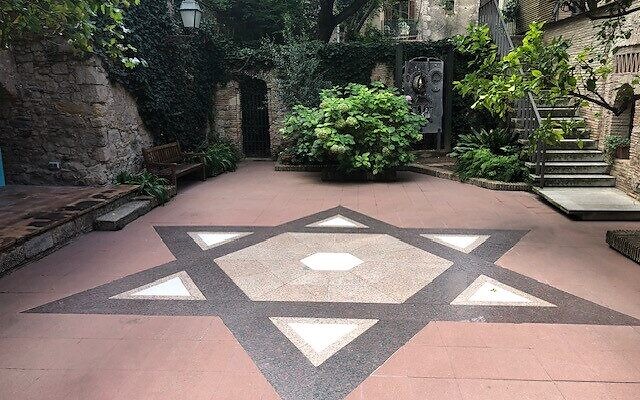A Walk Through Medieval Jewish History
The Spanish city of Girona offers one of Europe's best preserved Jewish quarters.
Dave Schechter is a veteran journalist whose career includes writing and producing reports from Israel and elsewhere in the Middle East.
These are tough times for Jews.
(So, when have times not been tough? asks the off-stage announcer in the back of my mind.)
“In fourteen hundred ninety-two, Columbus sailed the ocean blue.” That ditty has helped countless schoolchildren memorize a date in history.
Fourteen hundred ninety-two was also the year that the Spanish monarchy ordered the expulsion of its Jewish population.
I had planned this column for the AJT’s Oct. 15 edition but shelved it following the Oct. 7 Hamas-led attacks in which terrorists murdered 1,200 people and kidnapped 240 more.
It was written following our week in Barcelona at the end of September, during which we took a day trip to Girona, 38 minutes to the northeast aboard a “high speed” train, though the distance (100 kilometers/63 miles) was too short to open the throttle all the way.
As well as being a mecca for professional cyclists and the backdrop for scenes in “Game of Thrones,” the picturesque city offers one of Europe’s best preserved medieval Jewish quarters.
In the 1st century B.C.E. (Before Common Era), the Romans built a fortress, the Forca Vella, on the eastern bank of the Onyar River. The first recorded Jewish presence in Girona, some two dozen families, dates to the late 9th century C.E. The Jewish Quarter was established within the fortress in the 12th century.
In the Catalan language, the Jewish Quarter was known as “El Call,” which translates variously, including as a little street or alley. We walked along narrow, cobbled streets and stairs to the Museum of Jewish History, built into the remains of the last of Girona’s three synagogues.
The small, well-appointed museum tells the story of a community that thrived from the 11th to 13th centuries, then suffered degradations that culminated with the expulsion order of 1492.
The remains of a mikveh, discovered within the museum site during an excavation a decade ago, are visible. Other exhibits focus on family life, how the Jews of Girona lived, worked, and prayed, along with their culture and relations with non-Jewish Girona.
The museum houses an institute named for Bonastruc ca Porta, the Catalan name of Moshe ben Nahman Gerondi (“Moses son of Nahman the Gironan”), known as Nachmanides or as Ramban. In 1263, this Biblical commentator, Kabbalist, and chief rabbi of Catalonia argued the Jewish position in a famed debate — the Disputation of Barcelona — with a Dominican friar, himself a Jewish convert to Christianity, over whether Jesus was the Messiah.
Sitting in the museum’s courtyard, with the only sound coming from a breeze blowing through the greenery, my gaze was drawn to a large Star of David mosaic in the floor. Even in these tranquil surroundings there is an inescapable awareness of what befell the Jews in Girona and throughout Spain.
A municipal website says that “In the 14th century the ‘Call’ of Girona was a place of existence where both Jews and Christians had their homes and workshops.” But in 1391, thousands of Spanish Jews, including dozens in Girona, were killed in pogroms, spurring conversions to Christianity.
By the mid-1400s, the municipal government prohibited Jews from living west of quarter, even requiring the closure of doors and windows facing the street called Carrer de la Forca. Jews eventually were barred from living outside the quarter, from operating shops in certain areas of the city, or from touching a variety of food items.
Sitting in the museum’s courtyard, with the only sound coming from a breeze blowing through the greenery, my gaze was drawn to a large Star of David mosaic in the floor. Even in these tranquil surroundings there is an inescapable awareness of what befell the Jews in Girona and throughout Spain.
Presaging indignities five centuries later, another order read: “No Jew over the age of 15 shall leave the call or venture into the city without his/her Jewish outfit and without the red circle seen on the front of his/her clothes in a prominent place.”
Girona’s Jewish population, which peaked at about 1,000 in the 13th century, declined to about 200 by 1449.
The Alhambra Decree, the “Edict of Expulsion,” issued on March 31, 1492, by King Ferdinand and Queen Isabella, ordered that within four months Spanish Jews convert or be exiled. Estimates of the number who fled range from 40,000 to 200,000, while another 100,000 to 200,000 converted to Catholicism (though some risked practicing Judaism in secret).
Before a July deadline, the leaders of Girona’s Jewish community sold the premises of the last synagogue to the Catholic church.
For nearly 500 years, that structure remained private property. Over the past 30 to 40 years, though, civic honor has been restored to the history of a people expelled for their religious beliefs.
Preserving the Jewish Quarter has been good business, providing another reason for tourists to visit, while promoting good relations with Spanish Jewry (today numbering about 20,000, with maybe 125 in Girona), the global Jewish diaspora, and Israel.
A city website describes the Jewish Quarter as “one of the city’s most emblematic areas . . . clear evidence of the importance of the Jewish culture in Girona.”
Certainly, a change in attitude from the treatment the Jewish community suffered back when “Columbus sailed the ocean blue.”




comments